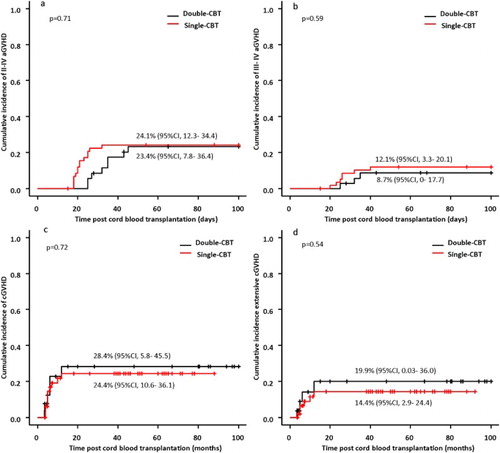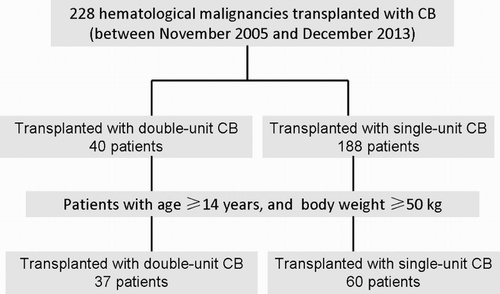Figures & data
Table 1. Patients’ and transplant characteristics.
Table 2. Cord blood characteristics.
Figure 2. Neutrophil and platelet engraftment. The cumulative incidence of myeloid engraftment at 42 days was 89.2% (95%CI, 72.7–95.7%) in the double-unit CBT group, and 96.7% (95%CI, 86.9–99.2%) in the single-unit CBT group (p = 0.026) (a). The cumulative incidence of platelet engraftment at 100 days was 70.3% (95%CI, 51.2–81.9) in the double-unit CBT group, and 86.7% (95%CI, 74.6–93.0)] in the single-unit CBT group (p = 0.057) (b).
![Figure 2. Neutrophil and platelet engraftment. The cumulative incidence of myeloid engraftment at 42 days was 89.2% (95%CI, 72.7–95.7%) in the double-unit CBT group, and 96.7% (95%CI, 86.9–99.2%) in the single-unit CBT group (p = 0.026) (a). The cumulative incidence of platelet engraftment at 100 days was 70.3% (95%CI, 51.2–81.9) in the double-unit CBT group, and 86.7% (95%CI, 74.6–93.0)] in the single-unit CBT group (p = 0.057) (b).](/cms/asset/39d2b106-1279-4c33-b50b-59d372eb73bf/yhem_a_1361078_f0002_c.jpg)
Figure 3. Acute GVHD and chronic GVHD. The cumulative incidences of grade II to IV aGVHD at day 100 in the double-unit CBT and the single-unit CBT groups were 23.4% (95%CI, 7.8–36.4) and 24.1% (95%CI, 12.3–34.4), respectively (p = 0.71) (a). The cumulative incidences of grade III to IV aGVHD in the corresponding group were 8.7% (95%CI, 0–17.7) and 12.1% (95%CI, 3.3–20.1), respectively (p = 0.59) (b). The cumulative incidences of cGVHD and extensive cGVHD at 5 year were 28.4% (95%CI, 5.8–45.5) and 19.9% (95%CI, 0.03–36.0) in the double-unit CBT group, and 24.4% (95%CI, 10.6–36.1) and 14.4% (95%CI, 2.9–24.4) in the single-unit CBT group, with no differences between the two groups (p = 0.72, 0.54) (c) and (d).

Figure 4. TRM and relapse. The 5-year cumulative incidence of TRM was significantly higher in the double-unit CBT group when compared with that of the single-unit CBT group [54.1% (95%CI, 36.5–68.7) vs. 33.3% (95%CI, 21.7–45.4), p = 0.026] (a). The 5-year relapse was 13.5% (95%CI, 4.8–26.8) in the double-unit CBT group and 11.7% (95%CI, 5.1–21.3) in the single-unit CBT group (p = 0.82) (b).
![Figure 4. TRM and relapse. The 5-year cumulative incidence of TRM was significantly higher in the double-unit CBT group when compared with that of the single-unit CBT group [54.1% (95%CI, 36.5–68.7) vs. 33.3% (95%CI, 21.7–45.4), p = 0.026] (a). The 5-year relapse was 13.5% (95%CI, 4.8–26.8) in the double-unit CBT group and 11.7% (95%CI, 5.1–21.3) in the single-unit CBT group (p = 0.82) (b).](/cms/asset/d84d3a88-91de-4ea7-97c7-c6d488e6aea3/yhem_a_1361078_f0004_c.jpg)
Table 3. Causes of death.
Figure 5. Survival. The 5-year probability of OS was 37.8% (95%CI, 22.6–53.0) in the double-unit CBT group, which significantly lower than that of the single-unit CBT group [56.7% (95%CI, 43.2–68.1)] (p = 0.037) (a). The 5-year probability of DFS in the double-unit CBT group [32.4% (95%CI, 18.2–47.5)] was significantly decreased compared with that in the single-unit CBT group [55.0% (95%CI, 41.6–66.5)] (p = 0.017) (b). The 5-year probability of GRFS was 24.3% (95%CI, 12.1–38.8) among double-unit recipients, which significantly lower than that among single-unit recipients [50.0% (95%CI, 36.8–61.8)] (p = 0.006) (c).
![Figure 5. Survival. The 5-year probability of OS was 37.8% (95%CI, 22.6–53.0) in the double-unit CBT group, which significantly lower than that of the single-unit CBT group [56.7% (95%CI, 43.2–68.1)] (p = 0.037) (a). The 5-year probability of DFS in the double-unit CBT group [32.4% (95%CI, 18.2–47.5)] was significantly decreased compared with that in the single-unit CBT group [55.0% (95%CI, 41.6–66.5)] (p = 0.017) (b). The 5-year probability of GRFS was 24.3% (95%CI, 12.1–38.8) among double-unit recipients, which significantly lower than that among single-unit recipients [50.0% (95%CI, 36.8–61.8)] (p = 0.006) (c).](/cms/asset/438fd4e9-3002-41be-9ef5-d2e5e70e9af4/yhem_a_1361078_f0005_c.jpg)

